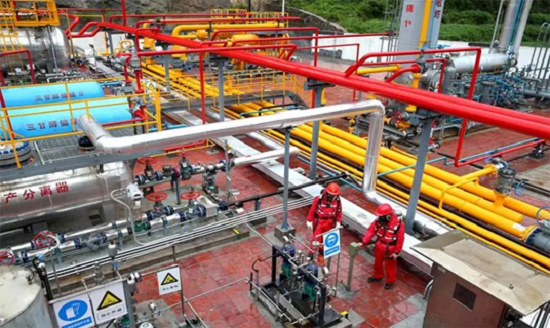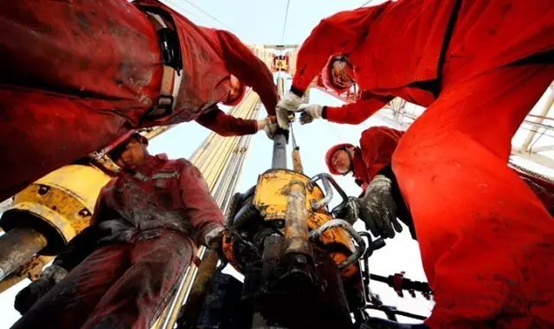During normal operations, we often face various situations, such as equipment failure, operational safety, material shortages, etc.
But in the face of emergencies, even fires, leaks, etc., how should we take measures to minimize losses? Let’s analyze the reasons and talk about how to deal with them reasonably.
1. Why is it required to “stop the pump late and start the pump early” when drilling quickly to connect a single root?
Because when drilling quickly, the drilling speed is fast and there are many cuttings. In order to overcome the poor suspension ability of the drilling fluid and prevent the drilling fluid from being stationary for a long time when connecting a single root, it is necessary to “stop the pump late and start the pump early” to shorten the drilling fluid stationary time as much as possible.
2. How to correctly judge whether the roller bit is stuck?
During drilling, if the torque increases (such as increased load on the rotary table, periodic jerking of the square drill rod, the tight and loose chain of the rotary table, the high and low sound of the diesel engine, the rotary table reverses after the rotary table is removed, etc.), the drill bit cone may be stuck, combined with the use time of the cone and the formation conditions. The drill should be circulated immediately.
3. What are the hazards of high-speed drilling?
① It is easy to overload the drilling rig;
② When there are complex situations underground, it is easy to pull out the drill bit (drill stuck);
③ The drilling speed is too fast, and once the air release fails, it will cause the top car;
④ It is easy to generate a large pumping pressure, resulting in overflow, well gushing, or collapse of the formation, making the originally normal wellbore complicated;
4. What are the hazards of drilling too fast?
① It is easy to cause abnormal wear of the brake belt, brake drum and large rope;
② Once suddenly encountering resistance, it is easy to cause accidents such as breaking the drill bit, blocking the drill bit or stopping the drill;
③ Producing excessive excitation pressure, it is easy to cause well leakage and well collapse;
④ Cause the drill bit to collide with the well wall and damage the teeth and bearings, reducing the service life of the drill bit;
⑤ It is easy for a large amount of rock chips to enter the drill bit from the drill bit water hole, which is easy to cause the pump drill bit water hole to be blocked;
5. How to deal with brake failure when lowering the drill bit?
First, the low-speed clutch should be engaged to slow down the slipping speed. The wellhead personnel should quickly engage the slip or buckle the lifting card, and all the staff should quickly leave the wellhead.
6. What is the reason for the twisting of the big rope during drilling? How to deal with it?
The reasons are:
(1) The new wire rope has not been loosened;
(2) The drill bit rotates severely during drilling;
(3) The big hook pin is not opened;
Handling method:
(1) Loosen the live rope head of the big rope to loosen the twist of the wire rope;
(2) Control the drilling speed to reduce the rotation of the drill bit;
(3) If the big hook pin is not opened, the drill bit can be engaged with the slip, and try to turn the traveling carriage to open the brake pin and loosen the twist;
7. Why do you need to open the big hook pin when drilling?
The main purpose of opening the big hook pin when drilling is to prevent the wire rope from twisting when the drill bit is put on and taken off. It is conducive to the rotation of the drill bit when there is a stabilizer in the well, and it is convenient for the second-floor platform and wellhead operation.
8. Why do you need to circulate the drilling fluid sometimes during drilling?
① The underground static time is long or the drilling fluid is circulated for some reason before drilling to prevent the drilling fluid performance from deteriorating or too much sand from settling, which causes difficulty in starting the pump;
② The underground formation may collapse;
③ The drilling fluid performance deteriorates due to salt water immersion and gypsum invasion;
④ There is a slight leakage in the well;
⑤ The underground situation is complicated and it is often difficult to start the pump;
⑥ The open hole section is long, the well is deep or there is a high-pressure oil and gas layer;
To prevent the above situation from worsening, the drilling fluid must be circulated in the middle.
9. What is the reason for the resistance when drilling? How to prevent and deal with it?
The reasons for the obstruction are:
① Pulling out the piston or not filling the drilling fluid properly causes the well to collapse;
② The performance of the drilling fluid is not good, resulting in thick mud cake and small wellbore;
③ The diameter of the drill bit is seriously worn, and the new drill bit causes obstruction;
④ Before pulling out the drilling fluid, the cuttings were not fully carried out of the ground in order to circulate the drilling fluid well;
⑤ The drilling tool structure changes;
⑥ The wellbore is irregular, with sand bridges or falling objects;
⑦ After the directional well is drilled with a power drill;
Prevention and treatment measures:
Before pulling out the drilling fluid, treat it well and circulate it fully. During pulling out the drilling fluid, fill it well according to regulations. If there is a stuck phenomenon, it should be reamed out. Before drilling, check the drill bit type in detail. If there is a change in the drilling tool structure, pay attention to prevent obstruction during drilling. If there is a piston pulling phenomenon during drilling, do not pull it hard. If there is obstruction during drilling, do not press hard. It should be reamed.该
10. When drilling down to the formation below the Dongying Formation and encountering obstruction, what should be paid attention to when reaming?
(1) Strictly abide by the principle of “one flush, two unblock, and three reaming”, and it is strictly forbidden to pressurize and lower while rotating to prevent reaming new wellbores;
(2) Pay close attention to changes in pump pressure to prevent pump blockage, and start the pump with a small displacement and gradually increase it;
(3) Handle the drilling fluid well, and increase the displacement to wash the well after the circulation is normal;
(4) Repeatedly ream the complex well section until it is unobstructed;
Post time: Jul-26-2024










 Room 703 Building B, Greenland center, Hi-tech development zone Xi’an, China
Room 703 Building B, Greenland center, Hi-tech development zone Xi’an, China
 86-13609153141
86-13609153141


